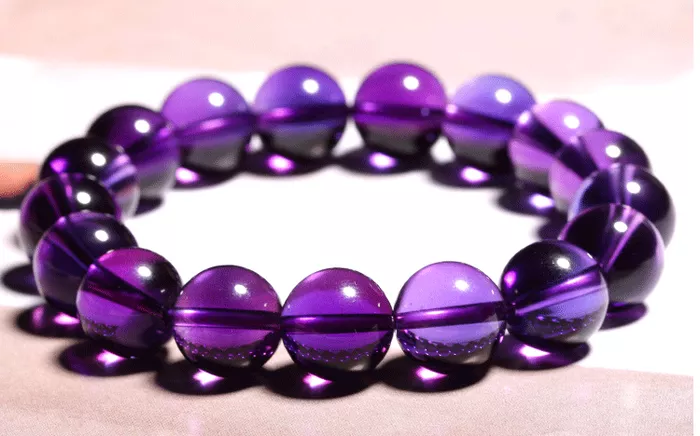Amethyst, a mesmerizing gemstone renowned for its captivating purple hues, belongs to the quartz family, composed primarily of silicon dioxide. It’s fascinating to delve into the geological and chemical makeup of this gem, revealing the secrets behind its alluring colors. Within the crystal lattice of quartz, trace amounts of iron and aluminum play a crucial role in shaping the gem’s distinct purple coloration.
Color Formation:
The enchanting purple of amethyst owes its existence to the presence of specific elements within its crystal structure. Primarily composed of silicon dioxide, amethyst incorporates trace amounts of iron and aluminum. These elements play pivotal roles in shaping its color profile.
Iron, when present as impurities within the crystal lattice, acts as the primary chromophore responsible for the distinctive purple hue of amethyst. Through complex interactions with light, iron imparts the gemstone with its characteristic color spectrum, ranging from soft lavenders to deep purples.
Aluminum, another essential component, contributes to the nuances and variations in the shade of amethyst. Its presence alongside iron influences the crystal’s color saturation and can give rise to subtle shifts in tone, adding depth and complexity to the gemstone’s appearance.
Natural and Enhanced Colors:
Amethyst occurs naturally in a range of hues, reflecting the diverse geological conditions under which it forms. From pale lilacs reminiscent of the soft blush of dawn to intense violets evoking the depths of twilight, natural amethyst showcases a rich tapestry of colors. These variations arise from factors such as the presence of other trace elements, geological processes, and the duration of crystal formation.
In some cases, natural amethyst undergoes heat treatment to enhance its color profile. This process, conducted under controlled conditions, involves exposing the gemstone to high temperatures to induce subtle alterations in its molecular structure. The result is a transformation of the gemstone’s hues into more saturated and vivid tones, intensifying its inherent beauty. While purists may prefer the untouched allure of natural amethyst, heat-treated specimens offer a spectrum of colors that cater to diverse aesthetic preferences.
Other Colors Associated with Amethyst:
While amethyst itself is renowned for its purple allure, it occasionally exhibits intriguing phenomena such as color zoning or banding. These phenomena manifest as distinct layers or zones of varying colors within a single amethyst specimen, adding an additional dimension of visual interest. Color zoning occurs due to fluctuations in the distribution of impurities or environmental conditions during crystal growth, resulting in striking patterns that captivate the eye.
In addition to its classic purple hues, amethyst occasionally gives rise to a rare and captivating variation known as green amethyst, or prasiolite. Unlike its purple counterpart, green amethyst emerges through a different alchemy—a result of heat treatment applied to yellow-green quartz. This process alters the crystal’s molecular structure, imparting a delicate green hue reminiscent of fresh spring foliage. Prasiolite possesses a unique charm, offering collectors and enthusiasts an opportunity to behold the beauty of amethyst in a verdant guise.
Ways to Wear Amethyst:
Amethyst’s enchanting beauty makes it a popular choice for a variety of jewelry settings, allowing enthusiasts to showcase its allure in different forms. From elegant rings adorned with faceted amethyst gemstones to intricately designed necklaces that accentuate its radiant hues, there are myriad ways to incorporate this captivating gemstone into one’s personal style.
For those seeking a subtle yet sophisticated touch, amethyst earrings offer a versatile option, effortlessly complementing both casual and formal attire. Whether worn as a solitary gemstone or combined with other complementary stones, amethyst earrings exude timeless elegance and understated glamour.
In conclusion, amethyst stands as a testament to the wonders of nature and the intricate interplay of geological forces. From its composition rooted in silicon dioxide and trace elements to the mesmerizing array of colors it exhibits, amethyst continues to enchant and inspire generations of gemstone enthusiasts. Whether in its natural form or enhanced through human intervention, the allure of amethyst remains undiminished, a timeless symbol of beauty, spirituality, and inner peace.


